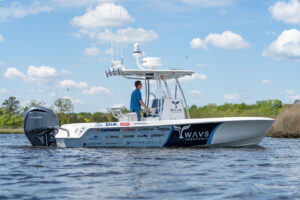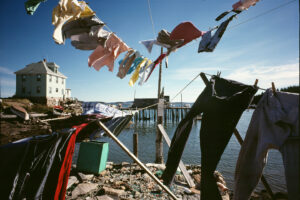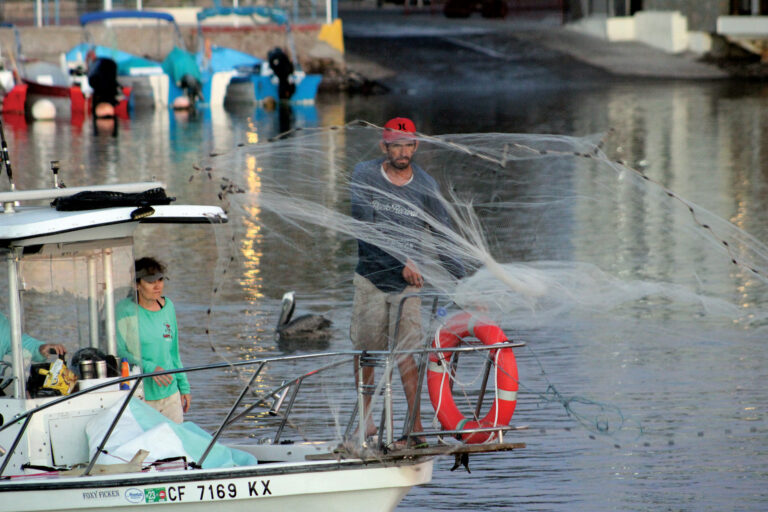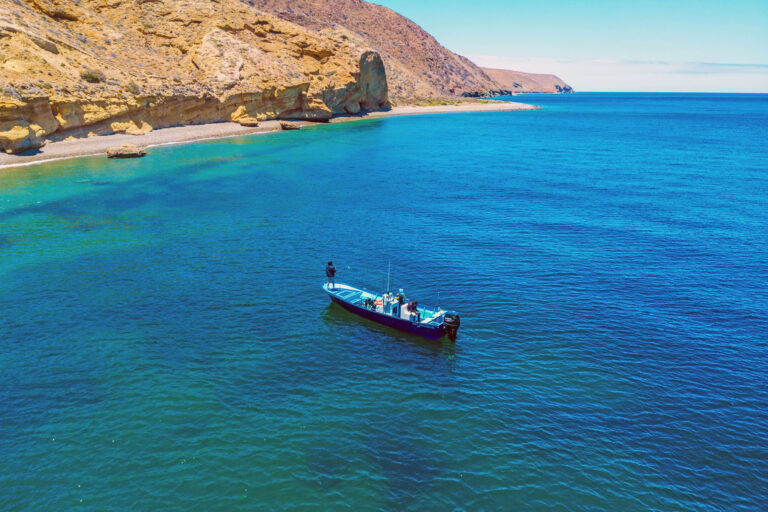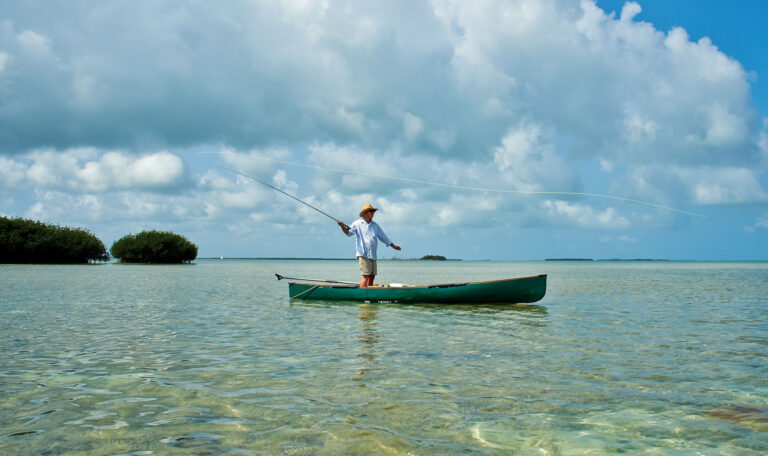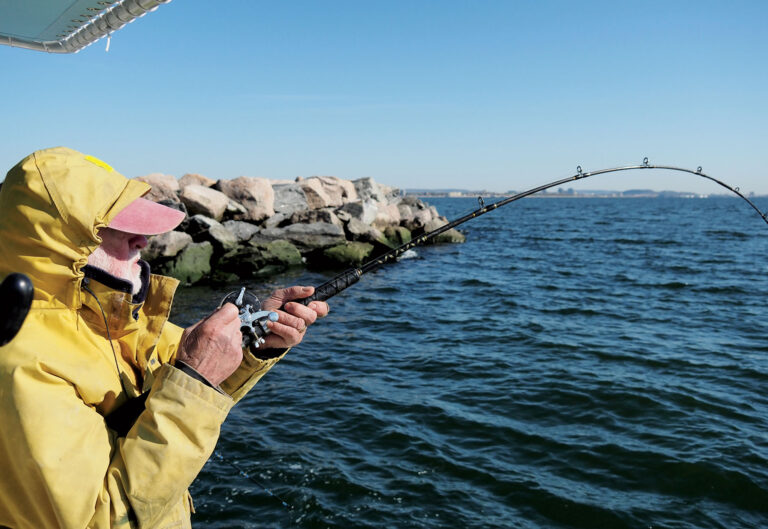The outer beaches of Cape Cod National Seashore in Massachusetts are the last remnants of coastal wilderness in southern New England. The 33 miles between Nauset Inlet and Provincetown Harbor are an unbroken, sparsely developed sandy shoreline. It’s a wild place, unlike any other I fish.
As a striped bass surf fisherman, I only fish at night, and the dark, lonely stretches of beach are often eerie. The wildlife seems bigger and bolder; I’m speaking primarily of the creatures that live in the water, but four-legged ones, too. And the stripers I seek are savage, wild-eyed and supercharged. Some anglers attribute this to the colder, highly oxygenated water. While I won’t argue, I think it’s more than that. Out here, on this spit of land jutting 27 miles out to sea, stripers are on edge, on high alert, all the time. There is just no room for even minor mistakes out here — by fish or by fisherman.
 Surf anglers must share Cape Cod National Seashore with seals and other wildlife in their nighttime pursuit of trophy striped bass.
Surf anglers must share Cape Cod National Seashore with seals and other wildlife in their nighttime pursuit of trophy striped bass.PREDATOR AND PREY
A horde of schoolie stripers follows me relentlessly. I catch glimpses of them in the wash, lit by a dazzlingly bright full moon — flashes of chrome in the vodka-clear water. Every cast I make is met with the sharp tap-tap of them yanking at my lure only moments after it touches down. It’s entertaining enough for a half-hour but quickly loses its appeal as “dumb” fishing. There’s no skill involved; they’d throw themselves at anything.
So I wander, meandering along the edge of the water, following fresh fox tracks at the wrack line. It’s easy to get lost and wander too far. The thought always nags at me, What’s around that next bend? Before long, I’m at least three miles from the buggy. I prospect frothy white water and jet-black troughs with a cast or two, covering ground, searching for greener pastures that hold cows. But it’s just schoolies everywhere. And seals: Clydesdale-size heads that pop up at intervals, accompanied by a loud whoosh of exhaled air. Sometimes they slide by so tightly to the beach that I glimpse their massive, black, torpedo-shaped shadows as they surf a wave, barely large enough to support their bulk.
 The outer beaches of the Cape are mostly uninhabited at night — by humans, that is.
The outer beaches of the Cape are mostly uninhabited at night — by humans, that is.Eventually I find myself at a pitch of sand that falls away steeply into a deep bowl. Waves break on the outer bar and spill into the depths of it. They don’t make it to shore, so the edge is as still as a tide pool but sinister in its deep-navy color, rejecting any penetration of light from the bright moon. To my left is a cut that dumps into the ocean. It looks like something out of a how-to-fish-for-stripers textbook. Wasn’t Tony Stetzko’s world-record 73-pounder caught from structure just like this?
I launch a cast so that it lands on the bar, and let the waves push the needlefish into the bowl. I barely stay in contact with the plug, but despite the slack in my line, I can feel what it’s doing — as much with my mind, as with my tactile senses. I’ve done this so many times it has become automated. My flow is interrupted suddenly by a violent bang. I set the hook explosively, and I’m tight to … another small fish. Frustrated, I fight the fish languidly, but I’m hopeful perhaps the next cast will be intercepted by something larger. The schoolie tugs and yanks, but it’s not very exciting on my heavy gear. Then the fish changes direction hard, heading back out. It’s so sudden I almost lose my balance, as blasé as I’m being. The fish turns, streaks left, then right in a manic back-and-forth. I can’t even react before it swerves again and is on the surface coming directly at the beach.
Behind it, a bulge of water builds and creates a wake. I curse and reel fast, lending speed to the fish’s desperate escape. I haul back, and it leaps, the moonlight glinting off its flank. It back-flips over the bulge, which then disappears as the creature sounds. But I know. I know it’s not gone, and I know what the stakes are. I jerk at the fish, hoping to pull the hook, and reel as fast as I can.
 “I know this is a special fish. It’s like when a horse shakes her head and your hands are on the reigns: You just hold on until it’s over,” the author writes.
“I know this is a special fish. It’s like when a horse shakes her head and your hands are on the reigns: You just hold on until it’s over,” the author writes.As the fish gets close, the bulge rises out of the depths again and matches the path of the panicked fish, charging the beach. The bulge of water becomes a wave with two huge, glimmering eyes breaking out of the front of it. I rapidly back-pedal, trip and fall, landing on my back, the rod butt jammed hard into the sand. The fish surfs the wave, tumbling out of the water and spilling onto the wet sand. As the wave rolls and breaks, the 700-pound body of a gray seal explodes out of it, unnervingly fast. I’m staring directly into the massive skull; the nostrils look big enough to fit my fist. It dives for my fish, only a foot away, as I spastically try to get to my feet. My motions yank the bass up the beach even farther, serendipitously just out of the seal’s reach. The behemoth stops, its body side-long to me, head higher than mine (prone as I am). We’re frozen for a moment, all of us, before it slowly turns and wobbles back to the water, slips in and is gone, leaving me and the fish floundering and gasping for breath.
COYOTE HUNGRY
I am working a cut in the bar with a soft plastic when Corey’s headlamp bursts on at full power. The beam, 100 yards away, sweeps the beach, the water and the dunes. It pierces through the heart of the night — a jarring disturbance in the inky black, making me suck in my breath, wincing, as it washes over me in a blinding column. What in the actual hell can he be doing right now, I think, holding up my arm to shield my face, blinking away spots. He knows using that much light is a cardinal sin: White lights kill bites. Yet he just keeps swinging his torrent all over the long stretch of sand, in the waves and up into the shrubby dunes. He walks up and down the shore, then toward the dune, then back down again.
A thought registers, cutting through the irritation: Something is wrong. I set off toward him to see what’s going on, but it takes me some time to cover the distance. As I do, I realize that he’s clearly looking for something. His beam freezes on the lip of the dune, where smooth, tawny sand meets the bright greens of beach grass and invasive rugosa rose. There is a sudden movement, then a twinkle of reflection low in the grass. I stop and stare. Like an image in one of those hidden-picture posters, the profile of a coyote slowly resolves as my mind sorts out the pattern. It just stands there, shaggy, tall and lean. I curse and start to jog. Not again.
 The magic happens between late night and early morning.
The magic happens between late night and early morning.I pull up in front of Corey, blinded by his light, and wave my hand in a silent signal for him to turn it off. “Well,” he yells over the crashing waves, “they dragged our backpacks up into the dunes. I was only standing about 30 feet from the bags and didn’t even know they snuck up behind me.”
“Damn it, not again,” I exhale, shaking my head.
“What?” Corey barks back. He can’t hear me over the din of the rolling surf.
“I said not again!”
“Yeah, well, this time they tore open my bag,” he says as he gestures to a disheveled pile of gear strewn nearby, “including all my food. I’m not sure what they got from yours.”
“All your food?” I look at him, knowingly.
“Yes. All of it.”
 You must fish through the small schoolies to find the real brute bass.
You must fish through the small schoolies to find the real brute bass.The subtext goes between us unspoken. Corey is diabetic, and we’ve been fishing all night. It’s 3 a.m., we’ve caught at least 120 fish, and we’re both exhausted. It’s an hour and 15 minutes of difficult walking to reach our buggies. I look over my shoulder, and the coyote has come down off the dune toward us and is standing 50 feet away, staring. Two more have shown up, perched like gargoyles at the crest, motionless.
“We need to get out of here. Now.”
The “Thing”
“This doesn’t feel like a seal,” Corey shouts. Even from a slight distance, I can see him gritting his teeth, can see the whites of his wide-eyed look. I reel in my plug and walk over to stand next to him. Line is peeling off his reel at a frightening clip. He leans back hard, which only results in line accelerating off the spool even more quickly.
“I was fighting a fish … felt like, maybe 12 pounds … had it right up to the backside of … the first wave,” he says, speaking in short, stuttered sentences, struggling against the strain. “And all of a sudden … it just … stopped. Like I was hooked to the bottom.” He starts to walk away from me, slowly, following the trajectory of his line. I follow. “Then it just started going out. Nearly pulled me into the wash. What the hell is this thing?” he asks, a look of shock lacing the features of his face.
“I’m not sure, but I think it could be a giant stingray,” I say, matter-of-factly. “Happened to me a few times last year. I saw one, one night. It had to be 6 feet wide, probably bigger.”
 A quick plug change to stay in the game.
A quick plug change to stay in the game. “No,” he says, incredulous. His drag never slows, never ceases its one-note song.
I shrug. “I actually got a fish back one night after dealing with this,” I say, gesturing at his screaming reel, then out to sea. “It was crushed. Its guts were coming out of its mouth. Totally dead, but not a single tooth mark on it. Squished.”
“Are you kidding me?” He doesn’t look at me, but laughs nervously. “The water here is only 2 feet deep! We crossed that trough to the bar just a few minutes ago. And it’s not like the fish I hooked is a little 5-pound rat. It felt decent!” All the while, line peels off the reel.
“Yeah, I know. The one I got back, the crushed fish, was at least 10 pounds. And the ray I saw slid so far up the beach the top of its body broke the surface.”
There is silence from Corey in response. The wind whines through braided line, and there is the persistent sound of the drag clicker. Time passes; we have no idea what to do next. “A stingray. No shit,” Corey says through clenched teeth.
He fights the thing for another five minutes, and at I step back to take a photo. After watching 250 yards evaporate off his reel without making any gains, he tightens the drag more and more until the line finally snaps. He looks at me. “I will never wade to the sandbar,” pausing for emphasis, “ever again.”
 Measuring over 47 inches, this fish put the angler through a limb-shaking fight. She’s tough, with a large scar breaking up her stripes.
Measuring over 47 inches, this fish put the angler through a limb-shaking fight. She’s tough, with a large scar breaking up her stripes.BATTLE-SCARRED STRIPER
I am getting hits, hooking fish or landing fish every few casts, and have been for hours. It’s the reward for putting in a lot of time on this beach. Stripers swarm the trough, riding in on the dense sheets of breaking waves. These fish are hitting with a savagery that only comes with extreme levels of competition. Reckless and unchained, they fight with an intensity that comes from living in the ocean. They aren’t like back-bay fish. They’re wilder, more savage and explosive — every fight at maximum capacity.
After a few hours, my arms shake with the strain of long casts and longer fights. I’m ready to go home, fully satiated, but I just can’t pull myself away. There is something in the air. Perhaps it’s a smell I am only vaguely aware of, or a subsonic pulse of the water vibrating through my boots and into my bones. I cannot say, but it is real; it’s more than a hunch. I know this is a night I can’t relent; the potential is just too great.
I cast again, connect with the darter and start the retrieve. This time there is no hit. The fish is on my line instantaneously, a hit-and-run strike. It feels big immediately, but I’ve been fooled before. She stops and swings her massive skull, rod bobbing against the power, and I know this is a special fish. It’s like when a horse shakes her head, and your hands are on the reigns: You just hold on until it’s over. You cannot stop it, no way to control that kind of power.
 The nights are long, and when the bite rages on a savage level, it is hard to pull yourself away from the water’s edge.
The nights are long, and when the bite rages on a savage level, it is hard to pull yourself away from the water’s edge.I scream to my friend, who is 100 yards away. “This is the one! Get over here right now!” My heart hammers, and I pant for breath as the fish and I duke it out. One more short run, and suddenly she’s close. There is a moment of suspense as a wave clutches at her and drags her out, right at the cusp of landing. She thrashes, frantically tail-slapping the wave, and I stagger forward, panicked, afraid of pulling the hook. The wave breaks and passes, and without reeling, I step back and drag her up the gentle grade.
Her bulk is impressive, and I drop to a knee to pull the lure from her jaws, hands shaking. My friend kneels to measure her. “Over 47 inches,” he proclaims, “gorgeous fish!”
My tripod and camera are set up for a shot, but she needs revival first. I rush to the edge of the waves and drop to my knees in the soft breakers. I gently set her down as they swirl around me. I cradle the giant in my arms, and she lists drunkenly. The summer water is warm, and she has fought hard. She pitches a bit, and I notice she has a white discoloration on her back. I stand her up straight, and it becomes clear — it’s a massive scar. The scales are missing, and the skin is rough and textured. The wound crosses her entire back, which is as wide as both of my hands, and runs partially down her body. Her dorsal fin is half-broken and torn. Otherwise, she is healthy and strong, though tired, and I can feel her muscles flex in my hands, her carmine gill rakes pulsing as she breathes.
The implication is clear. This fish, pushing 40 pounds, has recently been attacked by something huge. Something with the nerve to tackle a fish of her power and speed. Not even seals can manage that. Not with a healthy fish of this size, not a savage beauty like this girl.
And here I kneel at the edge of the surf, holding her out as if on a platter, inviting something to take another swing.



